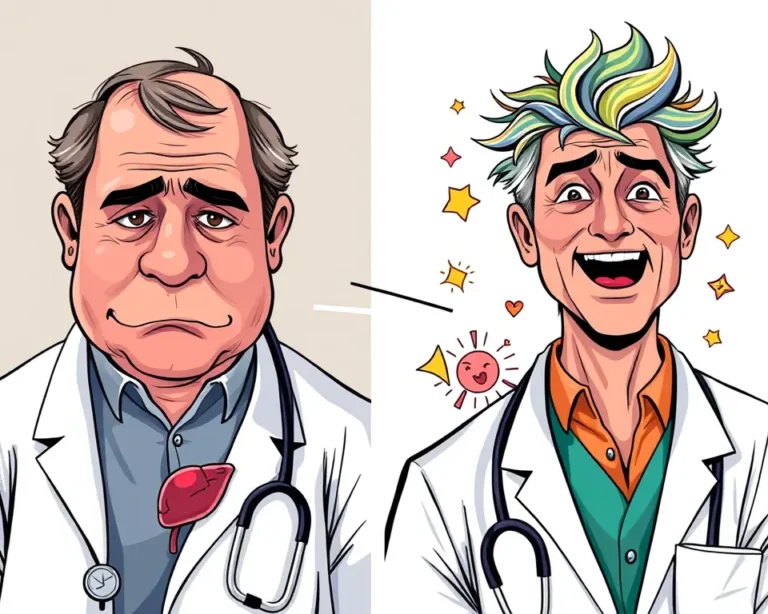A Chinese surgeon’s dramatic weight loss journey is making headlines, showcasing the power of lifestyle changes in combating health issues. Wu Tiangen, a 31-year-old doctor, shed an impressive 25 kg (approximately 55 pounds) in just six weeks after being diagnosed with fatty liver disease. His dedication to fitness has not only improved his own health but has also served as an inspiration to his patients and the wider community.
The Fatty Liver Wake-Up Call
In 2023, Wu Tiangen received a diagnosis of fatty liver disease and weighed 97.5 kg. Fatty liver disease, also known as non-alcoholic fatty liver disease (NAFLD), is a condition where excess fat builds up in the liver. While early stages of NAFLD often present no symptoms, it can progress to more severe conditions like non-alcoholic steatohepatitis (NASH), cirrhosis, and even liver cancer if left unmanaged. Some may experience fatigue, unexplained weight loss, or a dull ache in the abdomen.
Driven by the diagnosis and a desire to lead by example, Wu embarked on a rigorous fitness regime. He recognized the importance of lifestyle interventions, particularly diet and exercise, in managing and even reversing the effects of fatty liver disease.
The Six-Week Transformation
Wu collaborated with professional athlete Shi Fan to develop a structured and demanding training plan. The core components of his transformation included:
- Daily Exercise: Consistent physical activity was a cornerstone of Wu’s program.
- Consistent Sleep: Prioritizing rest and recovery to optimize his body’s functions.
The specifics of his gym routine, while not exhaustively detailed in initial reports, were clearly intense and targeted for rapid fat loss while likely preserving muscle mass.
Inside Wu Tiangen’s Gym Routine
While the exact details of Wu’s gym routine aren’t fully public, we can infer some likely components based on general weight loss and fitness principles, and the need to address fatty liver.
Cardio
Cardiovascular exercise is crucial for burning calories and improving overall health. Aiming for at least 150 minutes of moderate-intensity or 75 minutes of vigorous-intensity aerobic activity per week is generally recommended. Activities could include:
- Running: High-intensity calorie burning.
- Cycling: Good for endurance and lower body strength.
- Swimming: Low-impact, full-body workout.
- High-Intensity Interval Training (HIIT): Short bursts of intense exercise followed by brief recovery periods.
Strength Training
Strength training is vital for building muscle mass, which helps boost metabolism and burn more calories even at rest. A well-rounded strength training program should target all major muscle groups:
- Upper Body: Exercises like bench press, rows, overhead press, and bicep curls.
- Lower Body: Squats, lunges, deadlifts, and leg presses.
- Core: Planks, crunches, and Russian twists.
Aim for strength training at least two days a week.
Sample Workout Schedule
A possible weekly workout schedule for Wu could have looked like this:
- Monday: Strength Training (chest, shoulders, triceps)
- Tuesday: Cardio (HIIT or steady-state)
- Wednesday: Strength Training (back, biceps)
- Thursday: Cardio (moderate-intensity)
- Friday: Rest
- Saturday: Strength Training (legs, core)
- Sunday: Active Recovery (yoga, light walk)
The Impact of Exercise on Fatty Liver Disease
Exercise has proven to be a powerful therapeutic strategy for improving fatty liver disease. It works through multiple pathways:
- Improved Insulin Resistance: Exercise helps reduce insulin resistance, decreasing the excess delivery of free fatty acids and glucose to the liver.
- Increased Fatty Acid Oxidation: Exercise promotes the burning of fat in the liver.
- Decreased Fatty Acid Synthesis: Exercise helps reduce the production of new fat in the liver.
- Reduced Liver Damage: Exercise prevents mitochondrial and hepatocellular damage by reducing the release of harmful molecules.
Even without significant weight loss, exercise can benefit liver health by reducing liver fat, improving aerobic fitness, blood pressure, blood fats, physical strength, and body composition. It also improves energy levels, reduces fatigue, and enhances mental health and sleep.
The Risks of Rapid Weight Loss
While Wu’s transformation is inspiring, it’s crucial to acknowledge the potential risks associated with rapid weight loss. Losing weight at a rate exceeding 1-2 pounds (0.5-1 kg) per week can lead to several adverse effects:
- Muscle Loss: Rapid weight loss often results in the loss of lean muscle mass, which can decrease metabolism and strength.
- Lower Metabolism: The body may adapt to a lower calorie intake by slowing down metabolism, making it harder to lose weight in the long run.
- Nutrient Deficiencies: Restrictive diets can lead to deficiencies in essential vitamins and minerals.
- Gallstones: Rapid weight loss can increase the risk of developing gallstones.
- Electrolyte Imbalances: Can lead to abnormal heart rhythms.
- Fatigue, Irritability, and Anger: These psychological effects can make it difficult to sustain weight loss efforts.
Sustainable Weight Loss Strategies
For most people, a gradual and steady approach to weight loss is safer and more sustainable. Aiming for a weight loss of 1-2 pounds per week allows the body to adjust and minimizes the risk of adverse effects. This can be achieved through a combination of:
- Balanced Diet: Focus on whole, unprocessed foods, including plenty of fruits, vegetables, lean protein, and whole grains.
- Calorie Deficit: Create a moderate calorie deficit by reducing calorie intake and increasing physical activity.
- Regular Exercise: Incorporate both cardio and strength training into your routine.
- Lifestyle Changes: Adopt healthy habits such as stress management, adequate sleep, and mindful eating.
The Bigger Picture: Fatty Liver Disease and Lifestyle
Wu Tiangen’s story underscores the critical role of lifestyle in managing fatty liver disease. Beyond exercise, dietary changes are paramount. A diet for fatty liver disease generally includes:
- Fruits and Vegetables: Rich in vitamins, minerals, and fiber.
- High-Fiber Foods: Legumes and whole grains help regulate blood sugar and promote satiety.
- Limited Saturated Fat, Sugar, and Salt: Reducing intake of these can significantly improve liver health.
- Limited Alcohol: In some cases, complete abstinence from alcohol is necessary.
Weight Loss for Liver Health
For individuals with NAFLD, losing even a modest amount of weight (7-10% of body weight) can significantly improve liver health by reducing liver fat content, inflammation, and fibrosis.
A Victory Beyond the Scales
Wu’s dedication paid off not only in improved health markers but also in competitive success. He won multiple titles at the Tianrui Cup Fitness and Bodybuilding Match in January 2024, showcasing his remarkable physical transformation.
His story is a testament to the power of determination, healthy lifestyle choices, and the importance of doctors leading by example. While rapid weight loss can be risky, Wu’s journey highlights the potential for significant health improvements through dedicated effort and expert guidance. It’s a reminder that even after a concerning diagnosis like fatty liver disease, positive change is possible with the right approach. However, individuals should consult healthcare professionals before embarking on drastic weight loss programs.







